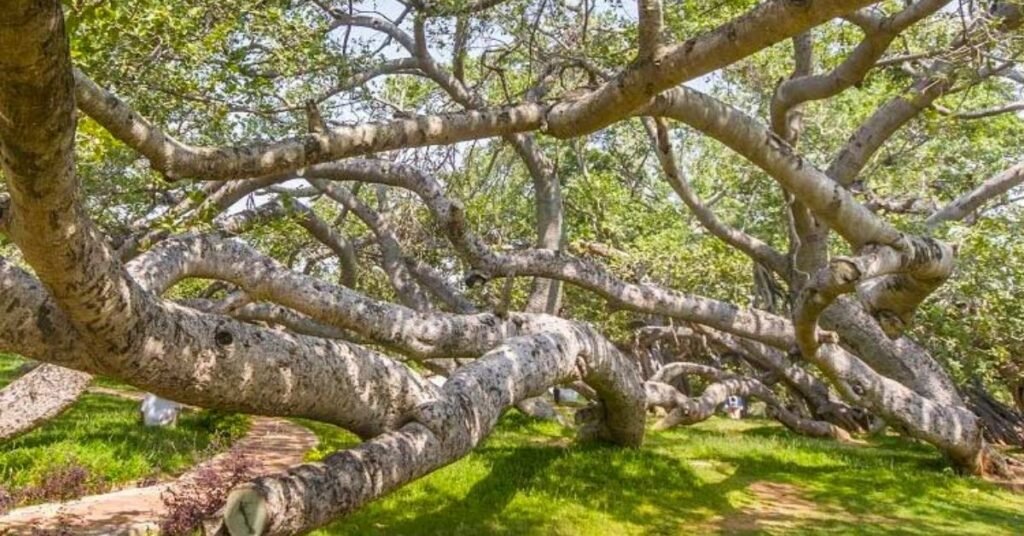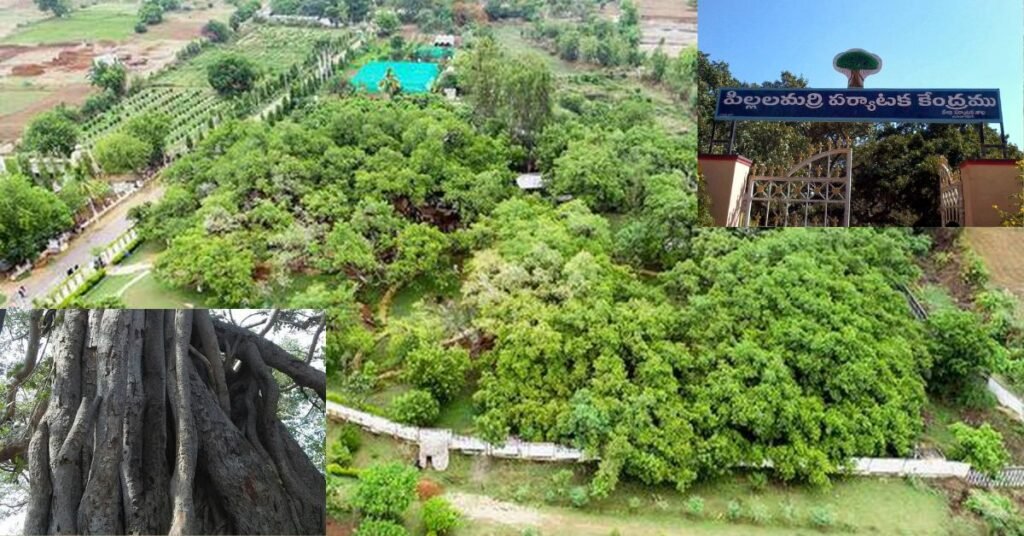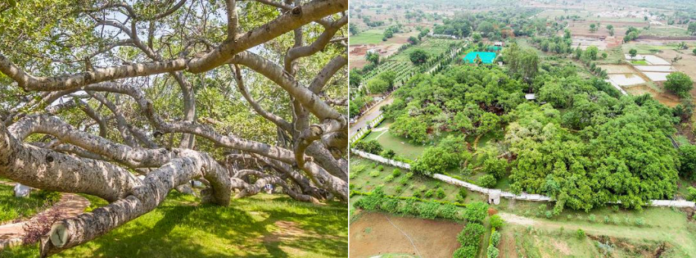Introduction:
When a Tree Feels Like a Kingdom.
The first time I visited Pillalamarri Banyan Tree, I made the rookie mistake of wearing sandals. As I stumbled over a gnarled root, my guide, Ravi, chuckled and said, “Respect the old one—she’s survived dynasties, droughts, and clumsy tourists.” His words stuck with me as I gazed upward. The tree’s branches stretched endlessly, forming a living labyrinth where sunlight danced like gold dust. Birds nested in woody crevices, and children’s laughter echoed under natural archways. It wasn’t just a tree—it was a universe.
But Pillalamarri isn’t merely nature’s marvel; it’s a time capsule. Let’s wander through its roots, stories, and secrets.

The Tree That Outlived Empires: A Saga of Survival
From Kakatiya Sapling to British-Era Wonder
Planted in the 1300s under the Kakatiya dynasty, a golden age of Telugu culture,e the Pillalamarri Banyan Tree began as a humble sapling. Local lore claims it was a royal gesture, meant to shade future generations. Farmers still whisper that the tree’s Telugu name, “Pillalu Marri” (“Children’s Banyan”), honors its role as a guardian of play and innocence.
By the 1600s, Mughal caravans paused here en route to Golconda’s diamond mines. Travelers tied colorful threads to its roots, praying for safe passage. Centuries later, British botanist Henry Ferguson wrote in 1892: “No illustration can capture its immensity—a forest masquerading as a single tree.”
Wars, Storms, and Silent Witnesses
In 1948, during Hyderabad’s annexation, villagers hid beneath Pillalamarri’s canopy as troops marched past. “My grandfather said the tree’s leaves rustled like warnings,” Ravi shared. Cyclones in the 1970s tore through Telangana, yet Pillalamarri stood firm—its aerial roots anchoring it like nature’s steel cables.
Also Read: Top 7 Must-Visit Destinations in India for a Perfect Family Vacation
Your Pillalamarri Itinerary: A Step-by-Step Guide
Essential Visitor Details
| Detail | Information |
|---|---|
| Location | Pillalamarri, Mahbubnagar district, Telangana (16 km from town center) |
| Nearest City | Hyderabad (100 km; 2.5-hour drive) |
| Visiting Hours | 9:30 AM – 5:30 PM (Closed Fridays) |
| Entry Fee | ₹20 (adults), ₹10 (kids), ₹50 (DSLR cameras) |
| Best Season | October–March (avoid monsoon’s muddy paths) |
Pillalamarri Banyan Tree Location On Maps:
Pro Tips for an Unforgettable Visit
- Sunrise Magic: Arrive by 7:30 AM (gates open early for photographers). The golden hour bathes the roots in ethereal light.
- Guided Tours: Hire Ravi (₹200/hour) at the entrance—his tales of hidden root tunnels and ghost stories are priceless.
- Footwear: Wear hiking sandals or sneakers—the terrain is a mix of soil, rocks, and sudden dips.
- Picnic Perfection: Pack a lunch! The tree’s cool shade is ideal for homemade pulao and mangoes.
Also Read: Pilgrimage Made Easy Daily Hyderbad-Srisailam Tour by Telangana Tourism
Traveler’s Toolkit: Gear to Elevate Your Trip
Must-Buy Essentials for Nature Explorers
- Anti-Slip Sandals: Columbia Drainmaker Shoes – Grippy soles for rocky paths (“Saved my ankles during monsoon!”).
- Collapsible Water Bottle: Hydro Flask Foldable – Stay hydrated without plastic waste.
- Compact Drone: DJI Mini 3 – Capture jaw-dropping aerial shots (₹50 drone fee applies).
Book Your Stay
- Budget Pick: Treebo Trend Mahbubnagar – Clean rooms, 10 km from Pillalamarri.
- Luxury Escape: Taj Krishna Hyderabad – Pamper yourself post-adventure.
Also Read: Miss World 2025 Contestants to Explore Telangana’s Heritage on Kakatiya Temple Tour
Beyond the Banyan: Hidden Gems of Mahbubnagar
- Koilkonda Fort (25 km): Trek to this 16th-century Qutb Shahi fort for sunrise views over granite hills.
- Alampur Temples (45 km): Marvel at 1,300-year-old Chalukyan architecture—a UNESCO World Heritage contender.
- Local Eats: Try Mahbubnagar kodi kura (spicy chicken curry) at Shadab Hotel.
Why Pillalamarri Isn’t Just a Tree, It’s a Teacher
On my last visit, I met an ecology student sketching the tree’s root system. “It’s a masterclass in resilience,” she said. “Each root supports the other. Imagine if humans did that.”
Pillalamarri’s lessons linger:
- Adaptation: Its aerial roots morph into trunks, ensuring survival.
- Community: Over 20 bird species nest here; the tree is an ecosystem.
- Legacy: It’s thrived by giving shade, oxygen, and inspiration.

Also Read: 10 Best Wildlife Safaris in Andhra Pradesh – Ultimate Guide
Conclusion: The Call of the Ancient.
As I left Pillalamarri at dusk, fireflies began their dance around the roots. Ravi had said, “This tree doesn’t need us. We need it.” He’s right. In a world of fleeting trends, Pillalamarri stands as a quiet rebel, a reminder that true greatness grows slowly, rooted in purpose.
Whether you seek adventure, peace, or a bridge to the past, this 700-year-old sage welcomes you. But tread gently. Future generations deserve to marvel at its whispers, too.
Your Turn to Wander.
Which fascinates you more—Pillalamarri’s history or its ecological magic? Comment below!
Share the Wonder: Tag a friend who’d love this mix of nature and history.
Ready to walk through history? Book your Hyderabad flights here and start your Telangana tale!
Final Thoughts
The Pillalamarri Banyan Tree isn’t just a tourist spot—it’s where time bends, myths breathe, and nature humbles you. With thoughtful travel choices (like supporting local guides), we can ensure this living legend thrives for another 700 years. For more offbeat escapes, dive into our guide on [India’s Hidden Natural Wonders].
Frequently Asked Questions (FAQs):
ANS: The tree is over 700 years old, planted during the Kakatiya dynasty in the 14th century.
ANS: It’s in Mahbubnagar district, Telangana, about 100 km from Hyderabad (2.5-hour drive).
ANS: Yes: ₹20 for adults, ₹10 for children, and ₹50 for DSLR cameras.
ANS: November–February for cool weather; avoid monsoon (June–September) due to muddy paths.
ANS: Yes! Tripods and drones are allowed (₹50 fee for drones), but avoid climbing delicate roots.











